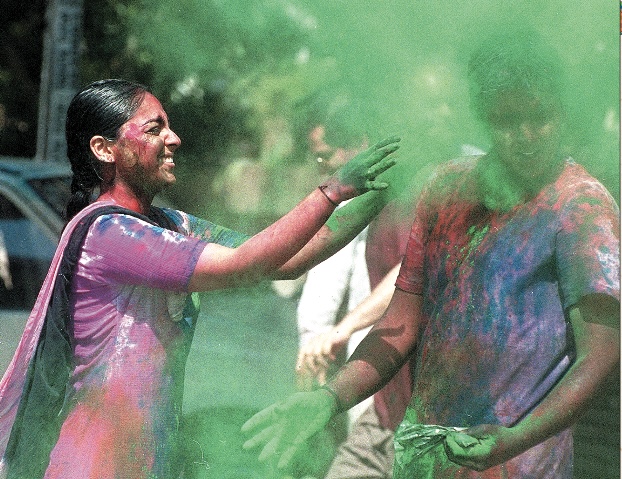By Tirtho Banerjee
The boisterous Holi revelers have a ready excuse, mano holi hai hai, “Don’t take offense, it’s Holi.” Their good-natured victims upon whom the colorful paints and powders have been tossed have no choice but to stay calm and go into an exasperating and sometimes unsuccessful scrubbing act. But ruined clothes are not their biggest problem. Many of these powders once made with natural, harmless ingredients are toxic.
Some are oxidized metals or industrial dyes mixed with low-quality oil. The green color comes from copper sulphate, a common agricultural poison. Purple is made from chromium and bromide compounds, both carcinogenic. Red is derived from mercury sulphite, which causes skin cancer; black from lead oxide [see page 62-63] and shiny hues from powdered glass. These toxin-laden colors can trigger skin irritation, allergies, hair loss, edema and erythema, blindness and even cancer. When washed off, these substances drain away to pollute public water resources.
The base in which these chemicals are mixed may be highly toxic, too. Several powders use a base of asbestos, talc, chalk or silica, all of which are health hazards. Asbestos is carcinogenic. An alkaline base can be found in many water colors. If it contacts your eyes, you can lose your sight. Hospitals treat Holi revelers every year for eye injuries, some of them permanent. Paste colors are mixed in a base of engine oil or other substandard oil which can result in skin injury, especially through the practice of some youth to completely smear the body with black, silver or white paste.
A study by Lucknow’s Industrial Toxicology Research Centre revealed that the eye-catching scarlet colors have Rhodamine B dye. It’sillegal in other countries for cosmetic or food use because it can induce cancer and genetic disorders. Degenerative changes in liver and kidney are also possible by application of these colors. A dye called Malachite green, used to treat fungus on fish, is carcinogenic. It can damage bones, eyes or lungs if consumed accidentally. The yellow color containing Auramine dye causes hepatic and renal disorders, mutagenesis and growth impairment. Combinations of these colors are doubly hazardous, say researchers.
But there is hope. Natural substitutes are on hand, and the demand for them shows that revelers value their health. Years back, the colors used for Holi were derived from plants. Yellow gulal (powder) was made from turmeric, green gulal from a mixture of mehendi and water. Other colors were produced from banana leaves, grasses, tree roots and flowers. These organic colors are set to make a comeback, now that the public is becoming aware of the hazards of the chemical colors. The National Botanical Research Institute is set to introduce a range of nontoxic and nonchemical plant-based colors. A team of scientists have developed 35 shades, including mauve, light and dark pink, lemon, yellow, saffron and indigo blue. The colors contain a dash of natural aromatic agentsÑsandalwood, khus, jasmine or lemon grass to give the right festive aroma. Colors are derived from hibiscus, tesu flowers, turmeric, indigo, barks of certain trees and bixa seeds. The soft green shade has been developed from leaves by extracting chlorophyll. Recipes are at http://www.cleanindia.org/btonature/holi.htm [http://www.cleanindia.org/btonature/holi.htm].
Last year’s Delhi “Celebrate Holi Naturally” campaign to propagate home-made, friendly colors had so many takers that the supplies quickly ran out, even though at us64¢, the eco-friendly packets were relatively expensive. “We could not meet the overwhelming demand,” said Vandana Shiva of the Navdanya organization, which produced the colors. Navdanya (http://www.vshiva.net/navdanya.htm [http://www.vshiva.net/navdanya.htm]) sells colored gulal and tesu petals, which are used as a wet color. “We use a base and edible colors for pink and red powder. Yellow is made with chandan, besan and turmeric, while green has gulmohar leaves and black uses rice bran,” said Shiva, one of India’s foremost environmentalists. Navdanya also offers a recipe book for home-made colors using gulmohar and heena powder for green, gainda and haldi for yellow, hibiscus and red sandalwood for red, jacaranda flowers, aparajita and indigo plant for a bluish hue and beet root, onions, amla and black grapes for magenta.
The revival of herbal holi has just begun. And it is sure to pick up this year as the natural colors will be cheaper to buy and fulfill their promise to bring back safe fun to this exuberant festival.
